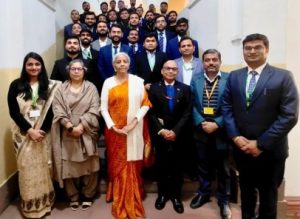Odisha aims for 25% jump in households consumption of millets

Photo credit Odisha Millets Mission
By Pradeep Kumar Panda
Bhubaneswar, April 5: Nearly 60 per cent of India’s cultivated area is rain-fed, the damage caused by climate change is huge in the agriculture sector. In order to save the farmers from climate stresses, there is imperative need of promotion of climate smart agricultural practices among the farmers.
Cultivation of millets is considered to be as one of the climate smart agricultural practices. In order to increase millet production in the country, Government of India has taken several initiatives under different policies formulated from time to time.
The important policies in this regard include Initiative for Nutritional Security through Intensive Millets Promotion (INSIMP) and Rainfed Area Development Programme (RADP) which are part of Rashtriya Krishi Vikas Yojana” (RKVY), and Integrated Cereals Development Programmes in Coarse Cereals based Cropping Systems Areas (ICDP-CC) under Macro Management of Agriculture (MMA).
Besides, the National Mission for Sustainable Agriculture (NMSA) adopted by Department of Agriculture & Cooperation, Ministry of Agriculture Government of India in 2014, has the objective of enhancing agricultural productivity especially in rainfed areas focusing on integrated farming, water use efficiency, soil health management and synergizing resource conservation. The programme has a mandate of improving millet production in the country.
NMSA derives its mandate from Sustainable Agriculture Mission which is one of the eight Missions outlined under National Action Plan on Climate Change (NAPCC). NMSA aims at promoting sustainable agriculture through a series of adaptation measures focusing on ten key dimensions encompassing Indian agriculture namely; ‘Improved crop seeds, livestock and fish cultures’, ‘Water Use Efficiency’, ‘Pest Management’, ‘Improved Farm Practices’, ‘Nutrient Management’, ‘Agricultural insurance’, ‘Credit support’, ‘Markets’, ‘Access to Information’ and ‘Livelihood diversification’.
India is their largest global producer, with a 41 per cent market share, and a compound annual growth rate of 4.5 per cent is projected for the global millet market in the coming decade.
Millet Production in Odisha
As per available statistics with the Directorate of Agriculture and Food Production, Government of Odisha, ragi is a major millet in the state followed by minor millets. The land area under millet cultivation in the state increased during entire 1970s and 1980s.
The linearly increasing trend depicts that during the twenty-year time period from 1970-71 to 1989-90, for each successive year, there was 6.27 thousand hectares of land area were added under millet cultivation. However, for the successive twenty- year time period, the trend is continuously diminishing. With each successive year during the period 1990-91 to 2019-20, there is a reduction of about 3.71 thousand hectares of millet land that are diverted for other crops. Similarly, there is also a secularly declining trend in the land area under small millets during last fifty years’ time period ranging from 1970-71 to 2019-20.
As per Government of Odisha statistics, during 1970s the average annual land area under ragi and small millet cultivation stood at 216.53 and 197.73 thousand hectares respectively. The ragi area per annum increased upto 289.38 hectares during 1980 and thereafter it is found diminishing continuously. During the corresponding period, the land area under small millets have also steadily declined. Perhaps due to lower yield rate of small millets, in the initial phase i.e., small millet farmers have diverted land used for small millets for ragis and in subsequent years, farmers have diverted much of their millet lands including ragi lands for other crops.
Despite increased yield rate of ragi as well as small millets over time during all the last five decades, Average annual production of ragi in the state has decreased from 243.79 (000 MT) in 1980s to 131.19 (000 MT) in 2010s. Annual average production of small millets in the state stood at 90.63 (000 MT) in 1980s which has decreased 12.07 (000 MT) during 2010s.
Jena and Mishra (2020) in their study also finds that during the 1960s and 1970s there was an increasing trend in area and production of millets and since 1980s, there was a reversal for millets with declining in area and production. The decline started first for small millets in the 1980s and subsequently since the 1990s for the three major millets – bajra, jowar and ragi. Decomposition of millets production indicated that that decline since 1980s is largely on account of area effect, but also because of yield effect in the 1990s and 2010s.
Special Programme for Millets in Tribal Areas of Odisha
Special Programme for millets in tribal areas otherwise called Odisha Millet Mission (OMM) evolved in 2017, after a state level consultation organized by Planning and Convergence Department, Govt. of Odisha on the subject “Comprehensive Revival of Millets in Tribal areas of Odisha” to secure Nutrition Security and mitigate drought in South Odisha held at Nabakrushna Choudhury Centre for Development Studies on January 27, 2016. This led to a series of interactions and a memorandum of understanding (MoU) was signed on 27 February 2017 between the Directorate of Agriculture and Food Production (DAFP) as the state level nodal agency that would monitor and implement the programme, NCDS as the state secretariat that would also anchor the research secretariat, and Watershed Support Services and Activities Network (WASSAN) that would anchor the programme secretariat as part of the state secretariat.
The date of signing of the contract was treated retrospectively as the start date of progrmme implementation. The programme period spans over a five-year time period from 2017 to 2022. The first three years of programme period constituted to be programme implementation phase and the subsequent two years comprise of consolidation, expansion and institutionalisation.
As per the Programme Guidelines, the key project objectives include increased household consumption of millets by around 25 per cent, enhancement of household nutrition security and to create demand for millets with special focus on women and children. (To be continued…)







